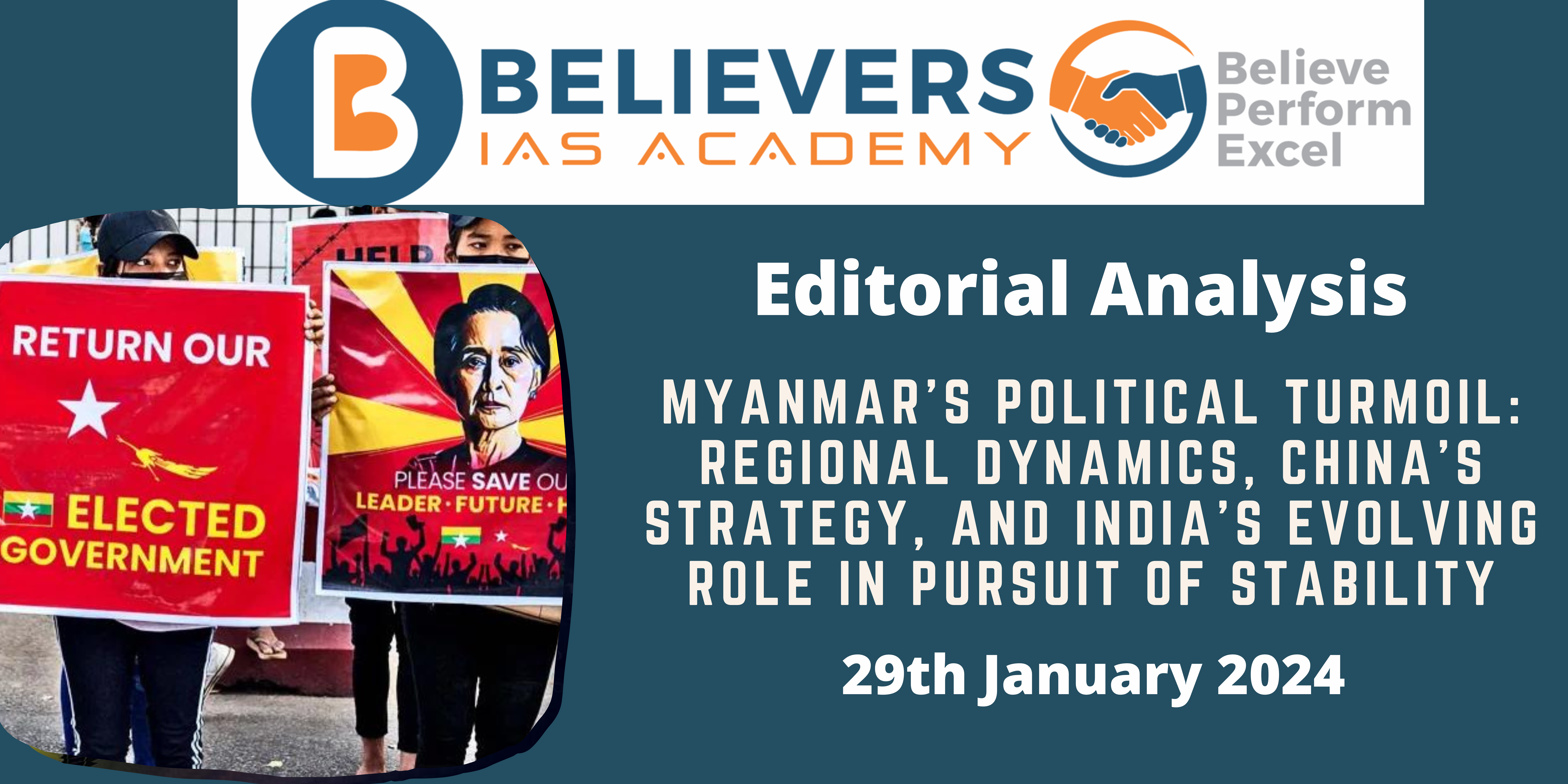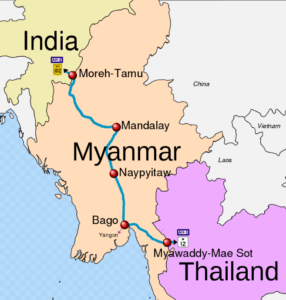Myanmar’s Political Turmoil: Regional Dynamics, China’s Strategy, and India’s Evolving Role in Pursuit of Stability
Context:
Myanmar’s political landscape has been in upheaval since the military seized power three years ago, leading to widespread protests and resistance. The unrest has resulted in territorial losses for the military to ethnic armed groups and the People’s Defence Forces (PDFs). China, with a complex strategy, aims to safeguard its interests amid the turmoil.
Relevance:
GS-02 (India and its Neighbours)
Mains Question:
Discuss the evolving political landscape in Myanmar post the 2019 military coup, considering the role of regional actors, challenges faced by the military junta, and potential strategies for stability. Assess the implications for neighboring countries, with a focus on India’s role in the current scenario. (250 words)
Dimensions of the Article:
- Historical Background
- The Unfolding Myanmar Crisis
- Military’s Territorial Losses and Popular Discontent
- China’s Multi-Layered Strategy
- Regional Dynamics and International Response
- India’s Potential Role and Humanitarian Approach
- Importance of Myanmar to India
- Cooperation between India and Myanmar
Historical Background:
- India and Myanmar share a profound historical connection rooted in cultural, religious, and trade ties dating back to ancient times. Both nations were part of British India during the colonial era until 1935.
- Post-independence, diplomatic relations were established, culminating in the signing of the Treaty of Friendship in 1951. The foundation for a stronger relationship was laid during the visit of the Indian Prime Minister in 1987.
- Key milestones included the reopening of the Indian Consulate in Mandalay in 2002 and the establishment of the Consulate of Myanmar in Kolkata. In 2014, Myanmar became an integral part of India’s “Neighborhood First” and “Act East” policies.
The Unfolding Myanmar Crisis:
- The military coup in Myanmar, which toppled the democratically elected government led by Aung San Suu Kyi, ignited a civil disobedience movement and armed uprisings.
- The National Unity Government, formed by deposed parliament members, established the People’s Defence Forces (PDFs), triggering armed resistance against the military junta.
Military’s Territorial Losses and Popular Discontent:
- Contrary to the military’s objective of strengthening national unity, they have faced significant territorial losses to ethnic armed groups and PDFs.
- The reasons for these losses extend beyond military incapacity, with growing popular discontent leading to challenges in recruitment and internal cohesion.
China’s Multi-Layered Strategy:
- China, a key player, defends Myanmar’s military on the international stage while maintaining close ties with ethnic armed groups along the northern border.
- Rumors suggest China leveraged ethnic alliances to address internal issues such as eliminating criminal syndicates exploiting Chinese citizens through online scams.
- Beijing orchestrated a ceasefire between rebels and the Myanmar army, showcasing its influence but leaving uncertainty about the truce’s durability.
Regional Dynamics and International Response:
- ASEAN has formulated a five-point consensus, excluding the Myanmar military from its summits, but struggles to alter Myanmar’s political trajectory.
- Thailand, with substantial influence due to a shared border, engages with Myanmar’s military and offers humanitarian assistance, signaling a more proactive regional approach.
- India, recognizing the evolving political landscape, should reassess its Myanmar policy, considering the ongoing discontent, resilient resistance, and the country’s fragmented political situation.
India’s Potential Role and Humanitarian Approach:
- India, with its historical ties to Myanmar, could adopt a more proactive humanitarian approach to assist displaced communities and address the refugee influx.
- A re-calibration of India’s Myanmar policy is suggested, emphasizing consultations with all stakeholders to navigate the complex and evolving political scenario.
Importance of Myanmar to India:
- Myanmar holds strategic importance for India due to its geographical proximity, sharing a 1,643 km land border and maritime boundary in the Bay of Bengal.
- It serves as India’s gateway to South-East Asia and plays a crucial role in countering China, particularly through the development of the Sittwe port.
- Additionally, Myanmar is a vital partner in addressing internal security concerns in India’s northeastern states affected by insurgent activities. The nations maintain robust economic cooperation, with India being one of Myanmar’s largest trading partners and making significant investments in sectors like energy, infrastructure, and agriculture.
- The historical and cultural ties, especially in the context of Buddhism, further strengthen the bilateral relationship.
Cooperation between India and Myanmar:
- Cooperation between India and Myanmar spans various areas, including trade and economy, connectivity, development assistance, defence collaboration, multilateral partnerships, and humanitarian aid.
- Bilateral trade has grown substantially, has crossed nearly $2.18 billion in 2016-17, and Myanmar benefits from a duty-free tariff preference scheme.
- Infrastructure projects like the Indo-Myanmar Friendship Road, the Kaladan Multi-Modal Transit Transport, and the Asian Trilateral Highway enhance connectivity.
- India has extended $2 billion in soft loans and contributes to Myanmar’s development through initiatives like the Myanmar Institute of Information Technology.
- Defence collaboration includes the India-Myanmar Bilateral Army Exercise (IMBAX), aimed at building closer relations and addressing insurgency issues in India’s northeast.
- Myanmar’s participation in regional organizations like ASEAN, BIMSTEC, and Mekong Ganga
Cooperation aligns with India’s “Act East” policy, providing a regional/sub-regional dimension to bilateral relations.
- Moreover, India has demonstrated solidarity through humanitarian aid, responding promptly to disasters such as Cyclone Nargis and providing assistance after earthquakes in Myanmar. The multifaceted cooperation underscores the depth and significance of the India-Myanmar relationship.
Way Forward:
- The trajectory of Myanmar’s political landscape remains uncertain, marked by ongoing discontent, territorial shifts, and external influences.
- Regional players, including China, ASEAN, Thailand, and India, need to adapt their strategies to address the complex challenges and contribute to stability and resolution in Myanmar.
- A collaborative and consultative approach, both regionally and internationally, is crucial to finding lasting solutions to Myanmar’s multifaceted crisis.





